Things to focus on before making a green house.
A quick list on things to focus on before making a greenhouse.
A greenhouse, often known as a glasshouse, is a structure
created to shield delicate or out-of-season plants from extreme cold or heat. When
growing flowers, food, or other plants that need particular circumstances, a
greenhouse often has a frame structure covered in plastic or glass which provides
the same circumstances are used. There are several factors to look out for while
building your own Greenhouse like Terrain, Humidity, Temperature and amount of
sunlight.
What is the Greenhouse effect or how does it works?
The term "greenhouse effect" describes conditions
in which the sun's short wavelengths of visible light pass through a
transparent medium and are absorbed, but the longer wavelengths of the heated
item's infrared re-radiation cannot. The long wavelength radiation is trapped,
causing more heating and a higher temperature as a result. The greenhouse
effect has been widely used to describe the trapping of excess heat by the
increasing concentration of carbon dioxide in the atmosphere, in addition to
the heating of an automobile by sunlight through the windscreen and the
namesake example of heating the greenhouse by sunlight passing through sealed,
transparent windows. Infrared is strongly absorbed by carbon dioxide, which
limits its ability to escape into space.
Things to look out for while building a green house.
1. Location and Orientation of the greenhouse
2. Shape or type of greenhouse.
3. Proportions of the greenhouse
4. Frame and form
5. Lights, water, action
6. Insulation
1. Location and Orientation of the greenhouse
The
location can make or break any venture. The type of structure your greenhouse
is made of and how much light it receives affect the plants' ability to thrive.
The location also affects the greenhouse owners' access to the building and the
building's susceptibility to storm damage. Also in frigid climates, it's
crucial to catch the first rays of sunlight. Hence the orientation of the greenhouse is extremely important.
2. Shape or type of
greenhouse.
The shape and size of the greenhouse depend on the location
and availability of land where it is to be built. There are several types of
Shapes and types of greenhouses available like Arch, Round, Gothic,
Traditional, Dome, and Wallipini where the greenhouse is partially underground,
Passive solar and Chinese types. And combinations of these are also available.
3. Proportions of the greenhouse
In order to optimise solar exposure while minimising heat
loss, structures should often be long and narrow. A greenhouse's daytime window
for solar gain is less if it is narrower than it is tall. The sun has much more
time during the day to heat up a place with a long east-west axis, which
accounts for the discrepancy. If you're constructing a freestanding greenhouse,
this is a very crucial factor to take into account. When starting off, many
homeowners choose a smaller glasshouse, but as many gardeners are aware of,
"one more" can soon fill a space. Contrary to common opinion, due to
their propensity for severe temperature swings, small greenhouses pose a
significant difficulty, even for seasoned producers.
4. Frame and form
The shape and materials of your greenhouse are two important
considerations. While many are constructed of many materials, some are made
entirely of glass or plastic. Others have pitched roofs, while others have
rounded ones. Each has advantages and disadvantages.
Framework: Aluminum, galvanised steel, plastic, or
wood are frequently used as structural support materials in greenhouses.
Because they are rust-resistant, lightweight, and sturdy,
aluminium and galvanised steel are suggested. The least expensive but least durable
pipes are made of PVC. They can operate in a temporary greenhouse or in a
moderate climate.
In a moist atmosphere, wood is prone to rot. Use only
pressure-treated wood, please.
Walls: For your greenhouse's sides, you can choose
glass, polycarbonate, clear plastic sheeting, fibreglass, or another material.
Additionally, companies sell greenhouse heat retention curtains.
Fibreglass is resistant to hail, lightweight, and strong.
You should use clear or translucent greenhouse panels.
Options for plastic greenhouses include clear plastic such
as polyethylene (PE), PVC, or other easily accessible transparent films.PE has
a lifespan of one to three years, depending on the type. Longer-lasting PVC and
co-polymers contain ultraviolet (UV) inhibitors.
Acrylic and polycarbonate are used to make double-wall
plastic covers. The sheets of two sturdy layers of plastic are separated by
webs. The double-layer material saves energy since it holds heat for a longer
period of time. Acrylic is durable and doesn't deteriorate over time;
polycarbonate, on the other hand, ages more quickly but is typically protected
by a UV-inhibitor coating.
A low-maintenance, weather-tight structure made of glass and
aluminium that preserves humidity and reduces heat loss. Two to three times as
strong as plain glass is tempered glass.
Glass has the drawback of being more easily broken, costing
more upfront, and requiring a stronger structure than fibreglass or plastic.
It also requires a strong base. From flea markets and recycling facilities,
recycled materials like old glass windows are collected.
5. Lights, water, action
There are some prerequisites for a successful hobby
greenhouse, regardless of the design, scale, or construction technique. The
following elements are necessary:
Electricity: Electricity access can help control temperature
and power fans and other habitat-controlling devices, whether you connect the
greenhouse with outlets or utilize an extension cord from the house. If you
don't want to deal with running energy to the greenhouse, solar-powered items
or do-it-yourself solar greenhouses can be more suitable.
Heat: In order for plants to grow and bear fruit in greenhouses, such as tomatoes and seedlings, as well as for tropical plants to
spend the winter there, heaters are required. You can set the desired
temperature with the thermostat included in some heaters.
Water: Having access to water is essential. Hand watering
with a garden hose is OK for the majority of greenhouse crops. There are
several different automatic watering solutions available for people with busy
schedules.
Air Circulation: When the greenhouse is heated in the winter, you must maintain air circulation to keep the temperatures steady. When there is no ventilation, warm air rises to the top while cold air gathers close to the plants at the bottom. Automatic vent openers are a must during the summer. They prevent greenhouses from overheating plus, the breeze is free.
6. Insulation
Insulation is essential for all the walls that do not have glazing on. Foam insulation or structural insulated panels work well but need to be sealed and kept dry as they are not rated for the humidity in a greenhouse. Also good to use Styrofoam on the inside of the SIP to eliminate any wood products.
Why Build a Greenhouse?
Year-round gardening Winter vegetables won't be harmed by
the cold or snow, so don't be concerned. Despite the cold outside, everything
thrives in the greenhouse’s-controlled climate.
Ideal growth environment: The greenhouse atmosphere ensures
sufficient heat and water vapour to support the growth of greenery, including
herbs, flowers, and vegetables.
Money-saving: Every spring, a lot of homes spend a fortune
on plants and grass for their outdoor gardens. You can grow as many seeds as
you want in a conservatory, and you probably will have more than enough to
share with friends and family as well.
Multi-purpose space: You won't need a garden shed if you
have a greenhouse because there is enough room for you to store tools and other
items.
Plant defence: Plants grown in greenhouses are shielded from
inclement weather and pest infestations including locust swarms, spider mites,
and caterpillars. In general, conservatory-grown plants are healthier.






876e49.png)
.png)




No comments yet